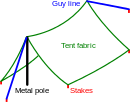Shelter-half


A shelter-half is a simple kind of partial tent designed to provide temporary shelter and concealment when combined with one or more sections. Two sheets of canvas or a similar material (the halves) are fastened together with snaps, straps or buttons to form a larger surface. The shelter-half is then erected using poles, ropes, pegs, and whatever tools are on hand, forming an inverted V structure.[1] Small tents like these are often called pup tents in American English.
Background
Shelter halves are a mainstay of most armies, and are known from the mid 19th century.[2] Often, each soldier carries one shelter-half and half the poles, etc., and they pair off to erect a two-man tent. The size and shape of each half shelter piece may vary from army to army, but are typically rectangular, triangular or lozenge shaped. When time and space allow, some forms of half-shelters can be combined into a larger, more complex tent.[3]
Shelter-halves are usually designed to serve double duty as
A commercially sold example known as a zelter shelter exists.[7]
Gallery
-
Camp Crane pup tents
-
Dutch Army pup tent from 1955
-
Two Polish Army shelter halves fastened together
-
Polish Army tent erected
-
GermanSplittermustershelter-halves in 1993
-
Russian plasch-palatka spread over ground
See also
References
- ^ Care And Use of Individual Clothing and Equipment Archived 2014-10-31 at the Wayback Machine, US Army Field Manual FM15-85, 1985, pp. 3–4ff
- ^ "Tent, Shelter Half (Pup Tent)". Olive-Drab. Retrieved 3 October 2012.
- ^ "Interesting gear: The Zeltbahn shelter-quarter". Philosophizing with a Hammer.
- ISBN 978-1860198694.
- ^ ISBN 978-5784101709.
- ^ a b Col. S.Burdin, "The Rear and Supplies of the Red Army" #9, 1942, in Russian
- ^ https://www.zeltershelter.com/







